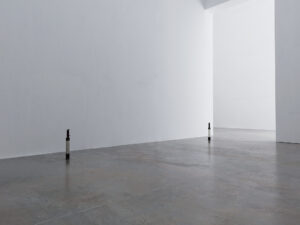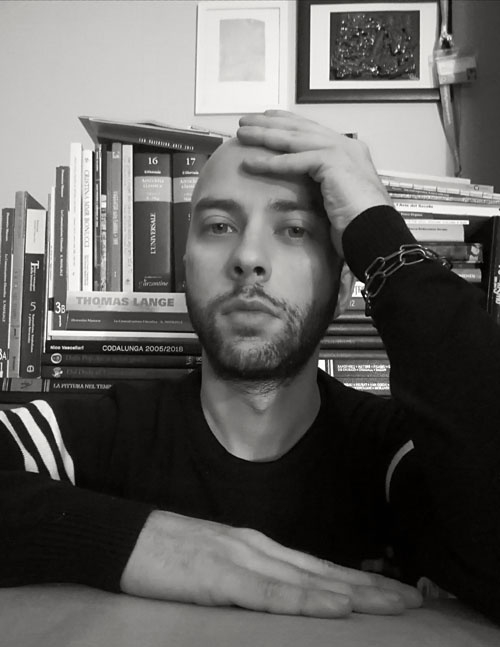Placeholder Sculptures, solo show by Francesco De Prezzo currently on view at FORM Space (Wageningen, NL) until 25 July, is a project that moves along the uncertain edge existing between the work of art and its perception, by investigating the relationship between content and mode of display. An exhibition, therefore, that constructively allows to interface with the action of silent factors whose influence, although decisive, is often relegated to the sidelines of the main narrative of an exhibition operation.

Francesco De Prezzo, Placeholder Sculptures, veduta della mostra, FORM Space, Wageningen (NL), 2023. Courtesy l’artista e FORM Space
Davide Silvioli: Into the heart of the present times characterized by a high-frequency and often inclined to standardization exposition system, what are the reasons behind an exhibition project such as this one, which faces the relationship between artwork and fruition?
Francesco De Prezzo: My relationship with art has been complicated ever since I started studying art-history books, realizing that I was looking at images of works and not works directly. At that point I wondered what the role of art historians, publishers and the public was towards those images that represented the protagonists of the narrative I was reading. Each work comes to our eyes through the shot of a photographer, who decides its pose, light, composition, and so on. We, therefore, must realize there is a series of collateral forces that define and modulate what we are used to call a “work of art”, regardless of whether it is a painting or a sculpture. Every choice related to these collateral aspects surrounding the work, even the smallest, has a direct effect on the reading of the work, to the same extent that, as example, talking at the bar with a friend one might become curious about a work, an exhibition or any artistic matter. Visual language, exactly like words, means nothing, it is the context that activates it. The photographic tripods presented in Placeholders Sculptures seem to replace, or rather anticipate with their presence the placement of future works, something closer to a scenic construction than a presence. Indeed, an exhibition without works or, if we prefer, without objects behaving like works.

Francesco De Prezzo, Placeholder Sculptures, veduta della mostra, FORM Space, Wageningen (NL), 2023. Courtesy l’artista e FORM Space
Mostly being accustomed to view works set up on walls, the exhibition space in Placeholder Sculputures, at first glance, can transmit a sense of absence. So, considering your research in painting, do you think it is plausible to argue that there is a sort of relationship between the removal of the subject that is distinctive of your practice in painting and the suppression, here practiced, of the conventions that normally constitute an ordinary exhibition?
Removing the subject from painting or the absence of sculpture in an exhibition are not only strategies of negation, but also ways of drawing attention to the processes, the relationships, and the contexts that shape our experience with art. Thus, there is a parallel. The placeholder sculptures and the process of erasure in painting are manifestations coming from the same intent: making space for a potential perceptual collateral. It seems there is an aesthetics of indeterminacy and openness, inviting the viewer to confront something that might change its shape or subvert its expectations, depending on how one defines it through the gaze.

Francesco De Prezzo, Placeholder Sculptures, veduta della mostra, FORM Space, Wageningen (NL), 2023. Courtesy l’artista e FORM Space
Referring to the general configuration of the project, featured by an aesthetic dimension capable of linking object, conceptual approach, analytical spirit, lettering, surreality and metaphysics, do the placeholders constitute as artworks themselves or, if this distinction makes sense, is the actual artistic operation to be found in the integrity of the intervention?
Placeholders Sculptures do not constitute as sculptures in the traditional meaning, but rather outline an interaction between viewer, space and expectation: they are much more than a work. The operation then does not end with the placeholders, but lies in the integrity of the intervention, in the dialogue amid these elements and in the way they take and mark a position, suggesting something to us, but in a very, very low voice; something with a subtle intensity, which requires an open listening, placed on a different level.

Francesco De Prezzo, Placeholder Sculptures, veduta della mostra, FORM Space, Wageningen (NL), 2023. Courtesy l’artista e FORM Space
Therefore, perhaps, in this case, to properly explore the contents of the project, reasoning about the work, the space and the exhibition considering them as three different things loses its sense, as well does talking about content and container. Hence, what was the actual subject of your work? The choice of an enigmatic element itself as the placeholders, or the physical space in relation to their placement, the context as a whole, or rather the response from the audience?
Exactly, it makes no sense to disconnect all these things, the subject of my work encloses the relationship among these elements. Have you ever seen an object detaching itself from its own shadow? The engagement of every viewer regarding what we will appropriately call “artwork” is, in truth, a process that is often unconscious and shaped by several elements. The visual is rather a socially negotiable fact.

Francesco De Prezzo, Placeholder Sculptures, veduta della mostra, FORM Space, Wageningen (NL), 2023. Courtesy l’artista e FORM Space
By deconstructing, so, the theory and praxis behind a usual exhibition apparatus, Placeholder Sculputures, albeit through a subliminal way, also wants to question the traditional systems by which art production is proposed and legitimized?
There is an important question intrinsic to the existing mechanisms that govern the art world, the hierarchies of space and evaluation, the modes of presentation, the tendency to reduce works to “interludes”. This project attempts to move between these aspects, by showing us a mode of presentation as if it were an art exhibition. Thus, the focus shifts from the individual work to the relationship established amid the object, the exhibition space and the viewer. As, sometimes, the modalities come before the contents, and the position of the sculptures come before than the sculptures themselves.
Davide Silvioli
Info:
Francesco De Prezzo, Placeholder Sculptures
19/06/2023 – 25/07/2023
FORM Space
Wageningen, NL
formatspace.org

Contemporary art critic and curator, he has curated exhibitions in galleries, independent and institutional spaces. He has lectured in Italy and abroad. His texts and research are published in catalogs, sector magazines, gallery editions and monographs. He is the curator of artist archives, contributor to specialized magazines and press offices. He collaborates with foundations, public museums, publishing houses and universities on research and curatorial projects.






NO COMMENT